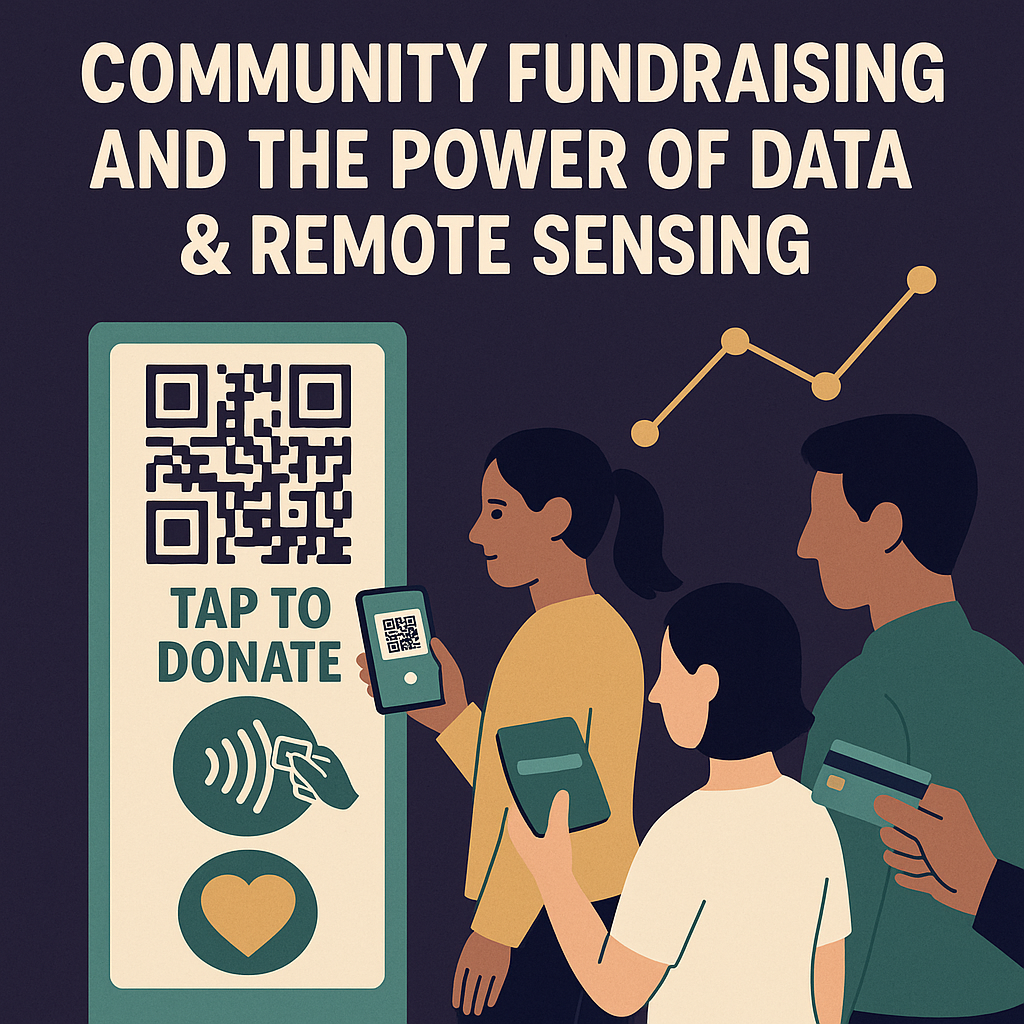Community Fundraising and the Power of Data & Remote Sensing
COMMUNITY FUNDRAISING
David Wallace-Hare
7/4/20253 min read


How QR, NFC, and Contactless Tech Are Rebuilding Local Giving Infrastructure
In a time of tightening resources, overextended volunteer bases, and increasing digital-first behaviour, community fundraising is being reshaped by remote sensing and embedded donation tech. Platforms like GiveTap, TAPiTAG, GoodBox, Give A Little, and Toucan Giving are helping charities and place-based initiatives modernise the humble donation tin into something dynamic, trackable, and surprisingly affordable.
This isn’t just about going cashless. It’s about putting smart, local infrastructure to work, capturing insights, enabling inclusivity, and supporting fundraising strategies that don't rely solely on in-person staff.
What Do We Mean by “Remote Sensing”?
At Placebased Agile, we borrow the term “remote sensing” from the environmental tech sector, where it refers to gathering data about ecosystems from a distance using sensors, drones, or satellites.
In the context of community fundraising, tools like QR codes, NFC tags, and contactless devices act as a form of civic remote sensing. They allow organisations to:
Record footfall and engagement in specific places
Collect data without needing volunteers on-site
Understand donor behaviour over time and space
In this way, these tools offer both donation functionality and a distributed sensing layer for community engagement.
From Collection Tins to Community Sensors
Today’s contactless donation tools combine QR codes, NFC tags, and Tap-to-Pay tech, embedded into:
Posters, stickers, and wearable badges
Branded contactless donation devices (static or portable)
Everyday items like medals, mascots, and event passes
These enable anyone in your community to give with a simple scan or tap—no app downloads required. And they’re not just passive collection tools: they’re mini-sensors, collecting data on location, footfall, time of engagement, and more.
Why This Matters for Today’s Charities
Many organisations today are operating without the volunteer capacity they once relied on. Whether due to the pandemic’s long tail, changing demographics, or burnout, some simply cannot maintain a presence at every stall, church, school, or event.
That’s where these tools shine.
💡 Remote sensing and contactless collection tech let you fundraise without staff on-site—while still gathering meaningful data.
Unlike cash-only giving:
These systems record footfall and donor interaction (taps, scans, conversions)
They support multimodal giving: card, smartphone, and often still cash
They allow for distributed deployment, so you can run a campaign across venues, boroughs, or postcodes
They yield actionable data—from which locations convert best, to what messaging works
Put simply, relying on cash alone may now actively hinder donations. It offers no demographic insight, no follow-up potential, and excludes digitally native donors.
Who’s Doing What?
A vibrant ecosystem of UK-based platforms is leading this transformation:
TAPiTAG - QR/NFC enabled branded donation tools (stickers and displays especially)
GiveTap – QR/NFC tags + silent auction tools: branded stations with campaign analytics (posters, displays)
GoodBox – Contactless kiosks/devices: real-time dashboards + custom hardware
PayaCharity (now Toucan Giving)– Device hire + QR/SMS: flexible rental + Gift Aid
Good Thyngs (now Toucan Giving) – QR/NFC on merchandise + print: interactive assets, no app needed
Give A Little – Tap-to-Pay via smartphones: no hardware required, fully app-based
LibertyPay (now Toucan Giving) – QR/NFC and contactless terminals: Gift Aid + branded microsites
Pennies – Micro-donation at POS: embedded in retail, round-up giving
Each offers a different approach to remote, embedded giving—from smartphone-led campaigns to full event infrastructure. The common thread? Decentralised, data-rich community fundraising.
Agile in Action: Testing NFC & QR Donations as a Sprint
If your team is unsure where to start with digital giving or short on volunteer capacity, you don’t need a massive rollout to get going. A smart, agile approach treats each idea as a Minimum Viable Campaign (MVC) — quick to test, easy to adjust, and rich in insight.
Agile Sprint: QR & NFC Giving Pilot in Local Shops or Mosques
Goal: Test whether community members will engage with QR/NFC donation prompts in familiar, trusted spaces.
Timeline: 1–2 weeks
Step 1 – Asset Mapping List 3–5 potential venues (e.g. mosque foyer, local bakery, charity shop counter) with foot traffic and trust.
Step 2 – Create a Minimum Viable Campaign
Print a basic A4 poster or larger or countertop display with a branded QR code + NFC sticker (using GiveTap or TAPiTAG) (a sticker is a fantastic addition to a collection pot making it multi-modal); this can also be a terminal pinned to glass or self-standing (cf. Toucan Pay (formerly Good Thyngs, LibertyPay, and Payacharity))
Include a clear message: why giving matters, where funds go, and a simple call to action
Highlight your donation methods: cash, card, Google Pay, Apple Pay, etc.
Step 3 – Soft Launch + Observe Install the posters with permission. Ask venue staff to observe interactions (but not manage them). Use donation platform data to monitor engagement.
Step 4 – Collect Feedback Use a short form, WhatsApp message, or verbal check-in to ask:
Did people notice the poster or try to tap/scan?
Did anyone ask questions or seem confused?
What would make it more noticeable or effective?
Step 5 – Reflect and Decide Review dashboard data and venue feedback. Decide:
Is it worth iterating or scaling?
Should we change the message, placement, or payment method?
Where did it work best—and why?
You’ve now run a remote-sensing fundraising experiment—generating real-world insight with low setup, low risk, and no volunteers needed on-site.
Final Thought
These technologies offer a powerful way to decentralise fundraising, capture real-time insights, and rebuild trust in giving—right where people live, gather, and care.
As funding models evolve, the ability to blend smart infrastructure with community connection may be one of the most important shifts in the future of charitable giving.
Empowering Local Charities & Community Organisations to Grow and Transform with Agile
Contacts
By email: sprint@placebasedagile.co.uk
By phone: 073499626390
© 2025. All rights reserved.


PlaceBased Agile is operated by David Wallace-Hare, a sole trader based in the UK. Registered business address: Suite A, 82 James Carter Road, Mildenhall, IP28 7DE
